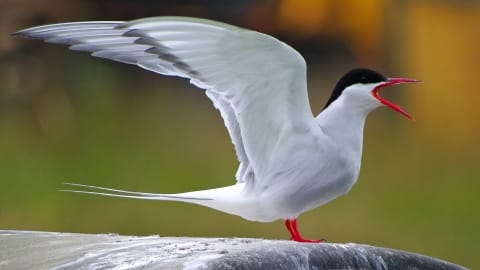Arctic Tern – (Sterna paradisaea)
The arctic tern sees more sun than any other animal as it has two summers every year due to it migrating around 70,900km from Iceland to the Antarctic coast. For those breeding in the Netherlands this figure can go up to 90,000km! In order to fly so far they glide a lot of the time, conserving far more energy than flapping their wings. They sleep whilst gliding, but as well as being able to glide very well they can also hover, a rare gift in birds, and usually attributed solely to hummingbirds. However, in order to do so for a long time they require some headwind.
The arctic tern is known for being ever so noisy, although just before a group migrates they become silent, known as the ‘dread.’ As whale watchers, we use their calls to find whales, as they are often the first clue. We can hear them signalling to each other from a long way off, even if the visibility is not great. As we get closer we can see a cloud of these birds repeatedly diving down into the water, making the most of the easy pickings. The fish are being pushed to the surface by the feeding whales, making hunting a much easier job for them!

Arctic terns are medium-sized birds, measuring 33-35cm in length with a wingspan of around 80cm. They mate for life and have a brilliant courting technique, starting with the female chasing the male high into the air and then slowly descending, this is called the ‘high flight’. After this comes the ‘fish flight’ where the male gives the female a fish. If this all goes well they then strut on land to each other, with the tail up and the wings down. Finally, they will fly around circling each other.
They are extremely territorial of their nesting sites, and will dive-bomb anything they see as a threat, pecking at the head of the predator. Despite their size meaning that they won’t cause any serious damage they are perfectly capable of repelling large predators, from humans even up to polar bears!
The females will lay 2 to 3 eggs, but their numbers are threatened massively by climate change. Global warming means sea levels will rise which will reduce their nesting grounds by 20%-50%. As well as that the large storms caused by climate change can be deadly to them as well as making feeding harder, and they can also disrupt breeding schedules. On the Red List of Threatened species it states that their adult population is in decline.
Here in Iceland, our seabird populations are in peril, with colonies shrinking and some having disappeared altogether. Here is an article by national geographic about it.
If you come across a nesting area whilst you are in Iceland please stay clear, stick to the paths and follow any signage. Please also do not use drones near them. Drones are banned in a lot of locations in Iceland, both for the pleasure of the other people in the area, so they can enjoy the silence of Icelandic nature, but more importantly, because the birds here will consider it as a threat. When the birds see something coming from above they assume it is a predator so will be stressed, may expend extra energy trying to fight against it or escape, and may even abandon their nests.
We often see the Arctic terns in our whale watching tours from Reykjavik Old Harbour as well as a huge range of other birds and mammals.
